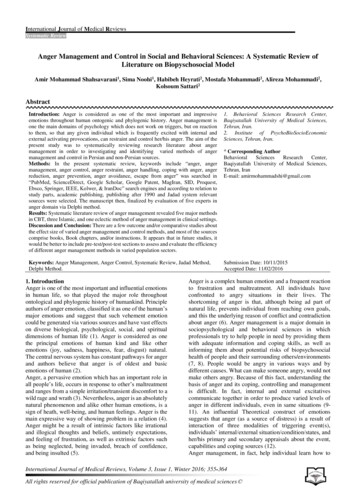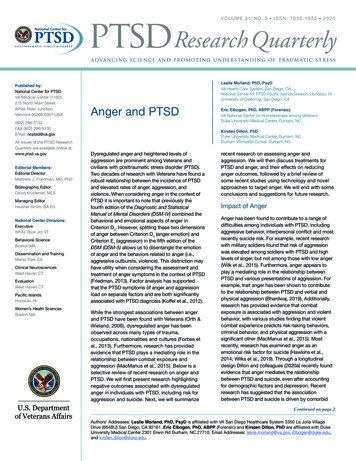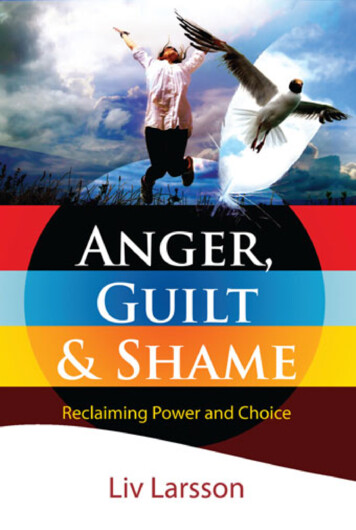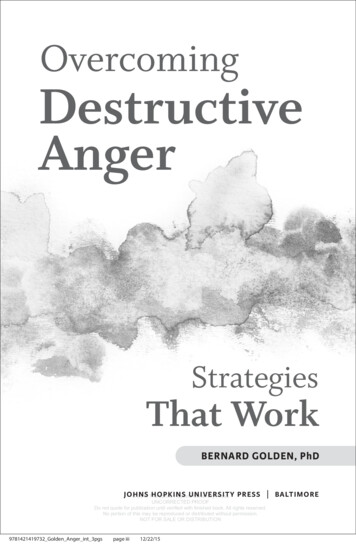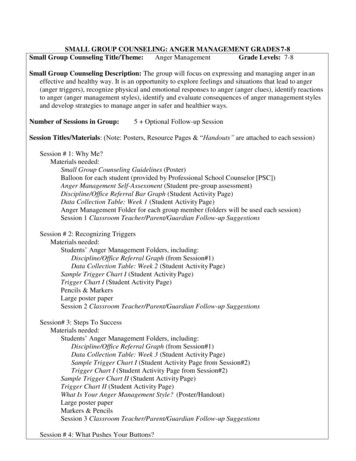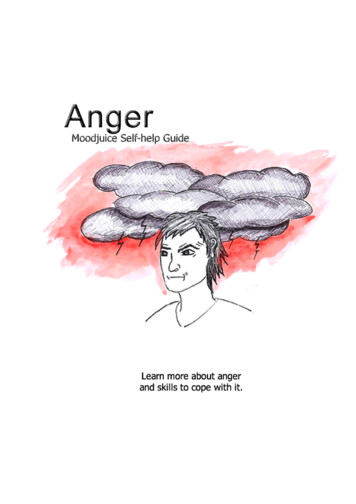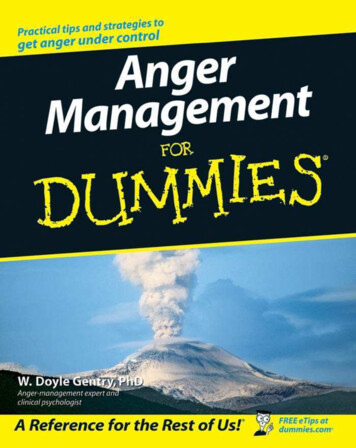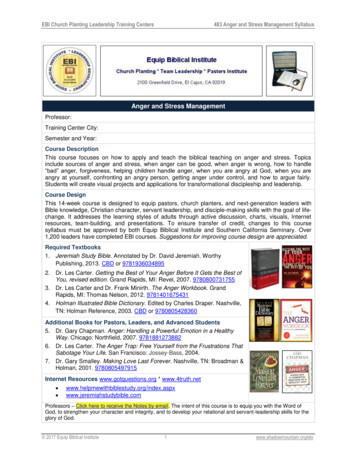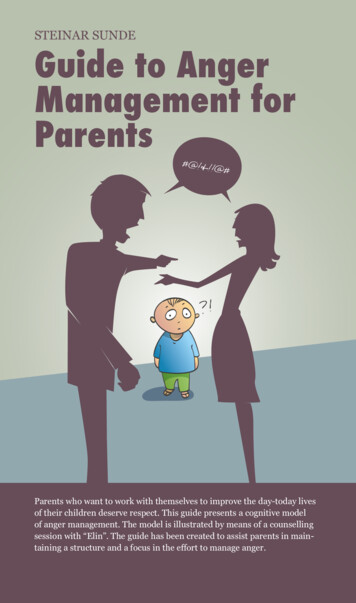
Transcription
STEINAR SUNDEGuide to AngerManagement forParents#@!&!!@#?!Parents who want to work with themselves to improve the day-today livesof their children deserve respect. This guide presents a cognitive modelof anger management. The model is illustrated by means of a counsellingsession with “Elin”. The guide has been created to assist parents in maintaining a structure and a focus in the effort to manage anger.
Guide to Anger Management for ParentsWhy do we get angry?Anger is a normal feeling that we all have. The question, therefore, is not whether we are angry, but what it is that creates thatanger and whether we feel we are in control of it. Anger canbe a necessary marking of limits for both adults and children.Children need secure adults who set predictable boundaries andlimits. The anger we are focusing on in this guide, is the angerthat is unpredictable for the child. It is a kind of anger that thechild is unable to understand and comprehend. Parents themselves are surprised at the force and unpredictability of theirown anger. Anger often arises when the parent or carer feelsstuck, helpless or powerless in a situation with the child. Angerthen provides a way of breaking out of the situation and escapingfrom the discomfort and pain (Isdal 2000). Parents want thebest for their children, and want to be good parents. But despitethis, about 20 per cent of parents find that they frighten theirchildren through anger or violent behaviour, and are worriedabout how this will affect their children. As long as parents donot know how to get help to manage their anger, many will try toplay down what happens and talk about it as little as possible.
Guide to Anger Management for ParentsThe ABC modelAnger management for parents is based on the classic cognitivetherapy model in which thoughts, emotions and behaviour areall connected. The model takes as its point of departure the factthat we all have an inner conversation going with ourselves.We interpret situations we find ourselves in all the time. Theseinterpretations are marked by negative automatic thoughts thatwe are often barely aware of: thoughts like, “I’m stupid, noone listens to me, she doesn’t care about me,” etc. In cognitivetherapy the focus is on working with these negative automaticthoughts and interpretations and showing how a change in thesethoughts can lead to a change in emotions. The aim is to becomeaware of the kind of thoughts that prevent or assist anger management. The ABC model is widely used in cognitive therapy tohelp people work systematically to change negative automaticthoughts. “A” stands for situation, “B” stands for thoughts aboutor interpretation of the situation, and “C” stands for emotionsand physical response. The ABC model is a way of illustratingthe relationship between the situation, thoughts and emotions.Parents use the model to train their ability to be aware of negative automatic thoughts about themselves (B) so that they can bemindful of them.The example that follows is that of a genuine initial counselling session with “Elin”. By reproducing the conversation, Iwill demonstrate how the ABC model can be used to help Elinto start taking control of her anger. Breaking out of negativethought patterns does not happen all by itself. Parents will need
Guide to Anger Management for Parentsto train over a period of time in situations with the child. Thesession with Elin concludes with specific suggestions for how shecan prepare practice situations with the child in between counselling sessions.The situationElin asks her five-year-old son Ole to turn off his computergame and go with her to the bathroom to brush his teeth beforebedtime. When he does not listen to her for the third time sheasks him to come, she gets angry, grabs Ole hard by the arm anddrags him into the bathroom. Ole yells and Elin holds him fastwhile she brushes his teeth. Elin drags the crying Ole into thebedroom, puts him to bed and says that tonight there’ll be nobedtime story since he has been so impossible. Elin leaves thebedroom, feels her heart beating hard and most of all feels shewants to cry. Why is there often so much conflict around bedtimes, and did the neighbours hear anything tonight?The initial sessionElin comes to the family counselling centre and says that sheneeds help with her son who won’t go to bed at night. The therapist (T) asks Elin whether she can describe a difficult situation that she remembers well. Elin says that as recently as theprevious evening there had been a situation when Ole did notlisten when she asked him to go to the bathroom. When he failsto listen to her she gets angry and takes him by force into thebathroom. Afterwards she feels like a bad mother. Elin says thatwhen Ole does not listen, it is as though she goes into a tunnelthat she does not get out of until Ole has gone to bed.T asks whether she has noticed any change in Ole’s behaviourfollowing difficult bedtime situations? Elin says that she contacted the family counselling centre because Ole has now startedgoing to his father instead of to her, and that Ole gets frightenedwhen she raises her voice. Elin says that it is a very upsettingfeeling for her that her son is afraid of her.
Guide to Anger Management for ParentsMapping negative automatic thoughtsElin says that she moves straight from a situation to an emotion– straight from A to C. She says that she does not have access toher thoughts and interpretations (B) until Ole is in bed. In thesessions with Elin, the initial focus is on helping her to see howher thoughts and interpretations (B) determine which emotions(C) are activated in her. “White stick” is an exercise that canbe useful for practising how to differentiate between thoughtsand emotions, while at the same time making one aware of howthoughts and interpretations (B) affect emotions (C).Figur 1A situation Ole does not listenB thought/interpretationC emotion Hopelessness/anger“White stick” exerciseT asks Elin whether it is OK that they do an exercise? T saysto Elin: Imagine that you are standing in a queue and someonecomes from behind you and kicks you hard in the calf. Before you turn round and see who is standing behind you, whatthoughts do you have about yourself? What emotions are activated? What is your body’s physical response? What do you wantto do?Elin replies that her thought is “who’s this idiot who’s kickingme in the leg?” Her emotion is that she gets angry and a littleafraid. Her heart starts beating fast. Elin says that she wantsmost of all to turn round and kick back.T then describes a new scene. When Elin turns round, she seesa blind man with a white stick. T asks her the same four questions again. Elin responds that her thought is now “poor man,he’s blind, he didn’t do it deliberately”. Her emotions changefrom anger to feeling sorry for the man. Her heartbeat slows andher breathing returns to normal in the course of a few seconds.
Guide to Anger Management for ParentsElin says she wants to help the man, to ask where he is going,and perhaps show him the way.T asks Elin what it is that has made her emotions and herphysical response change so quickly? Elin says that “when mythought is that he has not done it deliberately but by accident, itcauses quite different emotions in me in just a few seconds”.After this exercise, T asks Elin to tell him about the bedtimesituation once more – this time in a bit more detail before shegot angry. Elin is asked to describe their home. Where was Olesitting? Where did Elin come from when she approached Ole thefirst time?T asks Elin to describe what thoughts she is having aboutherself as she walks across the living room floor to ask Ole toturn off his computer game and go with her to the bathroom?Elin says that she is dreading the bedtime situation and thinks toherself that she hopes it will be OK this evening. T asks Elin whatshe is thinking about herself when she walks from the kitchenand across the living room floor to ask Ole for the second timeto turn off his computer game and go with her to the bathroom?Elin says that she is thinking that Ole is poorly behaved and thatno-one, not even her own child, can be bothered to listen to whatshe says.T asks what sort of emotions these thoughts make her have?Elin says that she has a feeling of hopelessness and anger, thatshe can feel her heart beating fast and her head is boiling. T askswhat thoughts Elin has about herself when she walks from thekitchen and across the living room floor the third time, to askOle to turn off the computer game and go with her to the bathroom? Elin says that she thinks that she is an incapable mother and that she is not respected. T asks what emotions thesethoughts get going in her? Elin says that she can feel the ragecoming and that she loses control of herself, because it is important for her to be a good mother and to be respected. Elin saysthat she has memories of a good childhood with kind parentsand that she cannot understand why she loses control. She isashamed of the way she reacts to Ole. The only explanation she
Guide to Anger Management for Parentscan think of for her anger is that it was important to be goodand clever and to achieve when she was little. Elin says that shethinks of herself as a bad mother when she is unable to achieveby bringing up an “obedient” boy.Elin has changed the experience she had of going direct fromsituation (A) to emotion (C), to being aware that she has severalthoughts and interpretations (B) that affect her emotions (C).Figur 2A situation Ole does not listenB thought/interpretation No-one listens to me Ole is poorly behaved I am a bad motherC emotion Hopelessness/angerMapping alternative thoughtsIf Elin’s negative automatic thoughts are not challenged, shemay accept them as true. Negative automatic thoughts are oftenlies about ourselves that arise when we least need them. Rating negative automatic thoughts on a scale, normalisation ofthoughts and mapping of alternative thoughts are ways of challenging negative automatic thoughts.T asks Elin whether she believes that the thoughts that she isa bad mother, and that no-one respects her, are true? Elin saysthat she knows that she does a lot of things well 90 per centof the time she is with Ole, but that the bedtime situations areharming their relationship. Elin goes on to say that she knowsthat she commands respect at work and that her partner respectsher, but when Ole doesn’t listen it is as though the bad, painfulemotion validates the negative thoughts she gets about herself.Rating on a scale from 1 to 10On a scale from 1 to 10, where 1 is a good mother and 10 is a badmother, T asks Elin where she would place herself? Elin saysthat while she is sitting in the therapist’s office she would placeherself as a 3, but in the situation when she gets angry with Ole itfeels like a 9. On a scale from 1 to 10, where 1 is being respected
Guide to Anger Management for Parentsand 10 is not being respected, T asks Elin where she would placeherself? Elin says that in her day-to-day situation at work andwhen she is with her partner, she would place herself as a 2, butin the situation when she gets angry with Ole it feels like an 8.Elin feels she has a realistic self-image most of the time, and yetnegative automatic thoughts manage to trigger strong emotionsin the bedtime situations with Ole.Normalisation of thoughtsAre Elin and Ole in an unusual situation, or do other parentsexperience something of the same? T asks Elin whether she hasheard of any other parents who have difficulties in getting fiveyear-old boys to bed at night, or whether she thinks that this is asituation that only she and Ole experience? Elin says that mostparents of five-year-olds whom she knows say that bedtimes canbe difficult. Elin says that she thinks that Ole does not appear tobe more difficult than the other boys in the kindergarten.Alternative thoughtsT asks Elin whether there are any other thoughts she couldhave about herself and Ole, when she is about to ask him for thesecond time to go to the bathroom, which would be equally trueor more true than the thoughts she had yesterday? Elin says thatshe could think to herself that for 90 per cent of the time she isa good mother and that most people respect her. Elin says thatshe could think that Ole is only 5 years old and that it is normalfor five-year-olds not to listen. Elin says that she could thinkthat Ole is concentrating so much on the game that he actuallydoesn’t hear what she is saying, and that it is not about him notshowing her respect. T asks Elin about what would happen withher emotions if she were to think those things? Elin says thatshe would then be able to walk calmly over to Ole, bend down,speak calmly to him, finish off the game together and, for example, have a race to see who could get to the bathroom first.Elin says that she can see that if she could manage to interpretOle’s lack of response as the behaviour of a typical five-year-old,
Guide to Anger Management for Parentsand not as criticism of herself as a mother, she would be able tohandle the situation in a completely different way. Through theconversation, Elin has become aware that her thoughts and herinterpretation of the situation (B), have a significant bearing onwhich emotions are activated (C). Elin says that she can see thatby practising to recognise and challenge negative thoughts aboutherself (B), she can take control of which emotions are activated(C).T asks Elin to award some white sticks to Ole. What could thewhite sticks be called? Elin says that she probably thinks manytimes to herself that Ole is poorly behaved and is rejecting herwhen he does not answer and that he is thus doing something“against her”. Elin says that a white stick could be that Ole isonly five years old and is in his own world of thoughts. He isnot rejecting me deliberately to be nasty or hurtful to me. He isjust very concentrated on what he is doing and a bit “blinkered”about what is going on around him. Elin sums up by saying thata white stick could be “Ole is only five years old”. Another whitestick could be “Ole is in his own thought bubble”.Using rating scales, normalisation of thoughts and mapping ofalternative thoughts will help Elin to challenge the negative automatic thoughts and identify alternative, truer thoughts aboutherself.Figur 3A situation Ole does not answerB thought/interpretation I am a good mother90% of the time I am respected Ole is only 5 years old Ole is in his ownthought bubbleC emotion Calm/feeling of controlFig. 3 on the worksheet, which Elin filled in, is an example of how to prepare for apractice situation with Ole. Elin changed (A) from “Ole does not listen” to a moreneutral interpretation “Ole does not answer”. Under (B), Elin gives some “whitesticks” to Ole and identifies alternative, truer thoughts about herself.Preparation for homeworkT asks how it would help Elin in a bedtime situation with Oleif she were to manage to give Ole one or more of these white
Guide to Anger Management for Parentssticks? Elin says she thinks it would be extremely helpful, toprevent her from feeling under attack both in terms of herself-respect and as a mother. T asks what it would take for Elinto be able to use, for example, a “white stick” as a tool for herselfin the next bedtime situation? Elin says that she can see she willneed to practise and maintain her focus over many evenings. Tasks Elin to imagine that she is walking across the living roomfloor for the second time, and asking Ole to turn off his computergame and go with her to the bathroom. What thoughts will shehave about Ole and herself then? Elin says that she will maintainher focus on the thought that she is a good mother 90 per centof the time. She will give Ole a “white stick” by thinking that heis only five years old; that he is in his own thought bubble andis not doing anything to provoke her. Elin says that she is excited to see how this focus will help and she is looking forwardto getting home to practise. Elin says she is highly motivated tomaintain the focus because it is very painful for her to see thatOle is afraid of her.SummaryThe ABC model shows that thoughts and interpretations comebefore emotions and affect emotions. Anger is a way of escapingfrom the discomfort caused by the feeling of being stuck andhelpless in the situation with the child. Being aware of how thephysical activation of emotions in the body can change in just acouple of seconds when one no longer feels under attack enablesone to choose solutions other than anger. Not feeling that one isunder attack is key to being able to think alternative thoughts inthe situation which stop one from going into the “tunnel” whereanger validates negative automatic thoughts about oneself.Recognising and challenging negative automatic thoughts is thestarting point for creating exercises to do at home in which Elinpractises anger management in between sessions.
Guide to Anger Management for ParentsHomework1. When you recognise a negative automatic thought (B), stopand give yourself a few seconds to be aware of what is happening.2. Recognising a negative automatic thought (B) prevents youfrom going directly from situation (A) to emotion (C).3. Ask yourself whether the negative automatic thought is true?Identify and bring up a “white stick” for the child, and analternative, truer thought about yourself, to experience whateffect they have on the feelings and emotions in the situationand how to manage them.From powerlessness to masteryBreaking out of a negative pattern of thinking does not happenby itself. It is necessary to practise over time in situations withthe child. Filling in an ABC worksheet from practice situationswith the child enables one to help oneself to manage anger. Asuccessful practical exercise gives a feeling of mastering the situation with the child, instead of the feeling of powerlessness thatoften precedes anger and violent behaviour.ABC worksheetB thought/interpretationC emotionTruth rating scaleA situation
LittsintAnger Management for ParentsYou can find more information at littsint.noFree e-book with 10 video clips showing a well-documented anger management model in a concreteway. Translated into several languages.Free app for IOS and Android, based on experiencesfrom sessions with 800 parents.This guide to anger management, littsint.no, e-book and anger management apphave been developed by Steinar Sunde with support from the Norwegian Directoratefor Children, Youth and Family Affairs. Sunde has been in charge of the work onanger management for parents and partners at the Family Counselling Centre inMolde since 2004.
limits. The anger we are focusing on in this guide, is the anger that is unpredictable for the child. It is a kind of anger that the child is unable to understand and comprehend. Parents them-selves are surprised at the force and unpredictability of their own anger. Anger often arises when the parent or carer feels
